Your Guide to Baby Crows: What You Need to Know!
Crows are some of the most remarkable birds in the world due to their unique intelligence and sociability. They not only know how to use tools (which is remarkable in and of itself) but have hectic social lives. In fact, many adult crows spend years or even their whole lives interacting with their children and even checking on other friendly crows in their neighborhood.
In this way, baby crows are particularly fun to study and understand. They often have many of the same traits and personality quirks as their parents, though they are often rarely seen. So, if you love crows or have a murder (the name of a group of crows!) in your yard, here’s what you need to know about their babies.
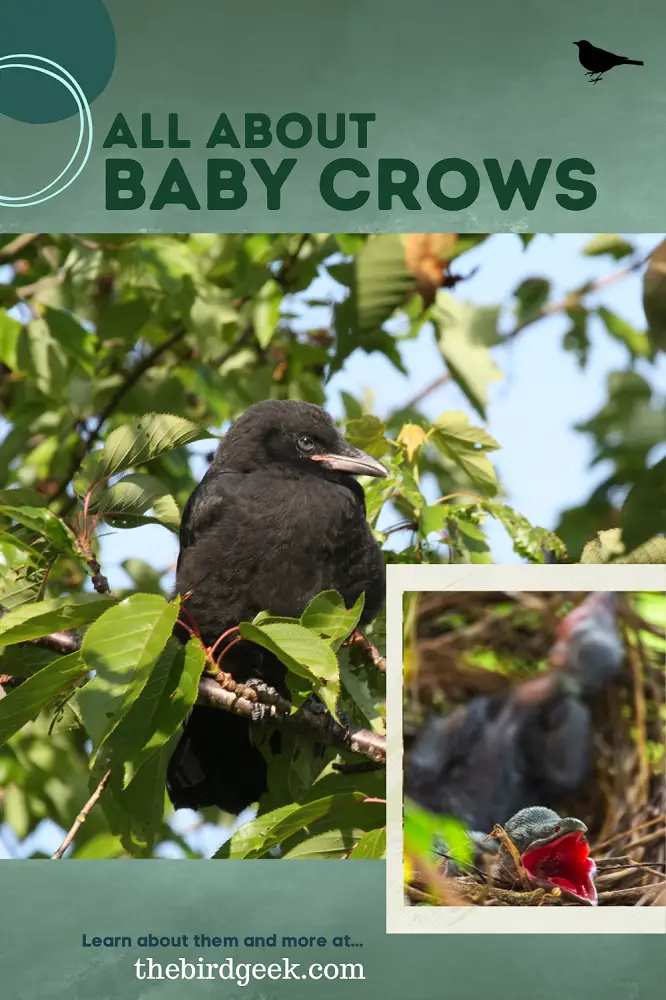
What Do Baby Crows Look Like?
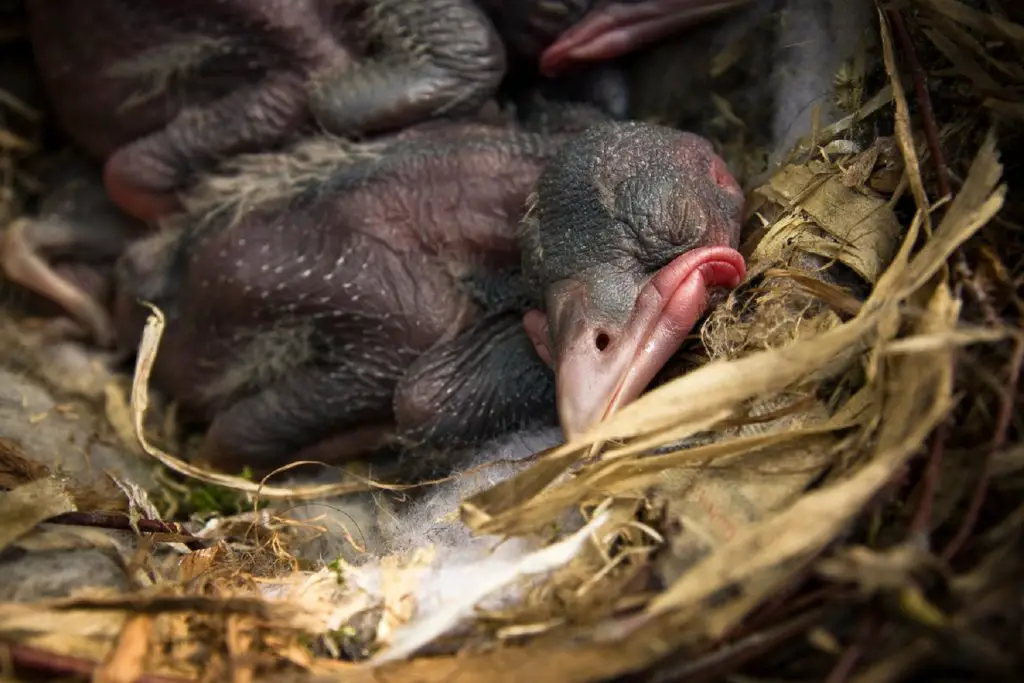
Image courtesy of Bugaga via Wikimedia Commons
Like most freshly hatched birds, crows look like adorable little fluff balls! At first, though, they’re almost entirely naked and have large pink bills with blue eyes. These beautiful blue peepers set them apart from other young birds and are typically consistent from youth to juvenile ages. That makes baby crows easier to spot from adults if you happen to see them.
As they mature, their fluffy down will start out as a relatively light black and then darken to the beautiful mature black you see in adult crows. Those stray white feathers you might find in a baby crow’s plumage will disappear or fall out. Expect a juvenile crow to look indistinguishable from an adult after about a year: there are still some differences but nothing major.
How Big Are Baby Crows?
Baby crows are just a few centimeters long (often under an inch) when they’re hatched. Like most birds, though, they rapidly grow to ensure that they can leave the nest quickly and avoid danger. Typically, they will reach adult size within just a month, though they may retain some elements of their youth, such as fluffy feathers and dependence on their parents.
That said, the varying crow species found throughout America means that baby size may vary heavily. For example, some crows measure as little as 42-48 centimeters (16.5-19 inches), while others get as big as 55 centimeters (21 inches). Accordingly, crow baby sizes will be slightly different, with some hatching out larger while others stay smaller.
You might also want to learn more about baby pigeons!
How Can I Tell the Difference Between a Baby Crow Versus a Baby Raven?
The biggest difference between crows and ravens is their size. A full-grown raven is typically twice the size of a crow and is comparable to a red-tailed hawk in bulk. Baby crows and ravens are the same, as the baby of a raven will be about double the size of a crow baby. You can also tell them apart based on their tail feathers, as ravens have longer middle feathers.
This gives both the baby and adult ravens a wedge-shaped tail, which differs heavily from the fan-like tail of the crow. Furthermore, ravens have a call that sounds more like a bullfrog than a crow! Lastly, ravens typically have curvier beaks than crows, including their babies, which can help you tell them apart if you happen to run across either in your outdoor travels.
What Do You Call Baby Crows?
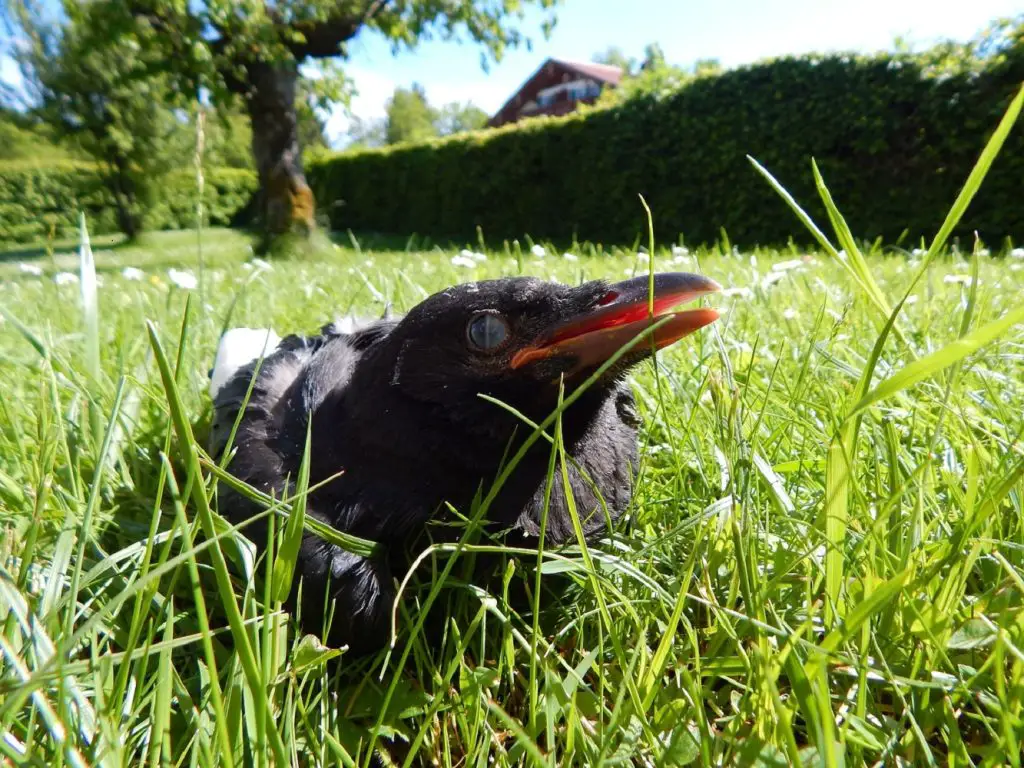
What you call a baby crow varies depending on its age. When they’re first hatched, they’re called hatchlings. During this period, they’re typically very small, fluffy, and demanding: one parent may stay at the nest at all times to guard and protect their crows. Once they’re a little older, they’re called chicks and are called this until they leave the nest.
Once they leave the nest and start hunting for themselves, crows may be called juveniles until their fathers lose their fluffiness and become more sturdy. However, some regions call year-old crows yearlings. These young crows are often the most fearless and intelligent, though not always the most rational: think of them as the teenagers of the crow world.
What Time of Year Do Crows Have Babies?
Crows have a pretty typical breeding season, which may vary slightly based on where they live. Typically, though, most will breed and lay eggs from early April through June. In the United Kingdom and areas with a similar climate, their nesting season is shorter, usually between April and May. However, their breeding season may heavily change as you travel to other parts of the world.
For example, they typically lay eggs in December, January, and February, or August, September, and October in Africa and more southern parts of Asia. Why is that the case? As you go south, the temperature gets warmer: once you go past the equator, what the Northern Hemisphere calls winter is summer. So, the warmest months are December, January, and February. Weird, huh?
You might also enjoy: There’s a bird nest with colorful eggs in my backyard!
How Long Do Baby Crows Stay On the Ground?
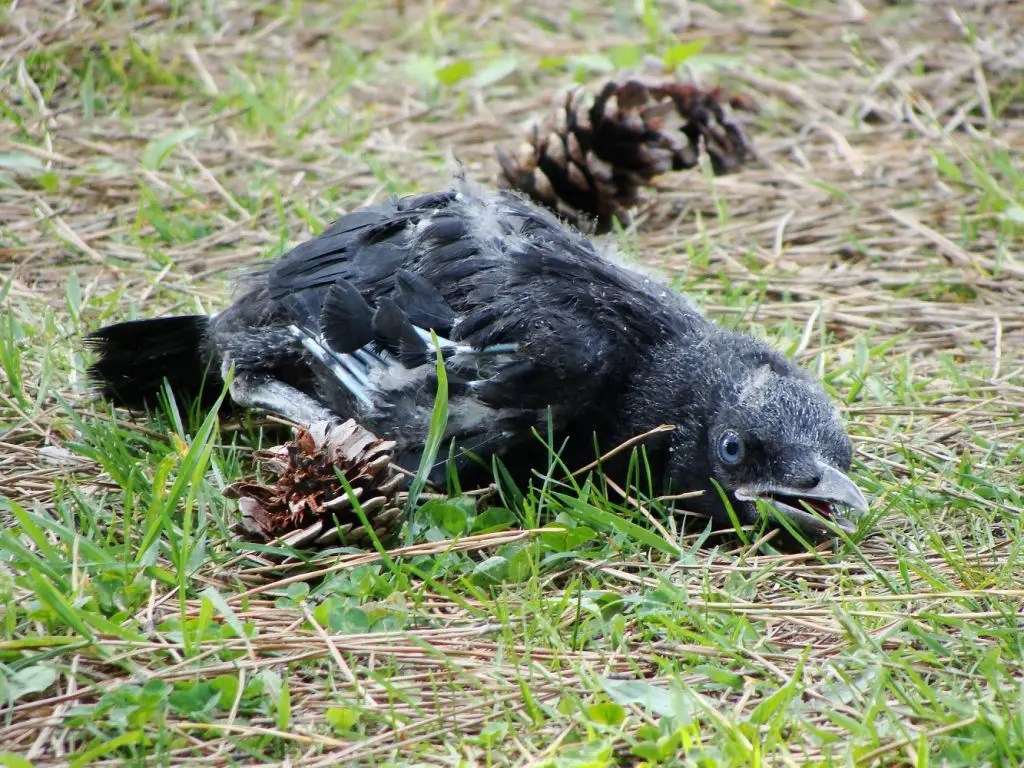
Image courtesy of Aomorikuma(あおもりくま), CC BY-SA 3.0, via Wikimedia Commons
One of the cutest things you’ll probably ever see is a baby crow perching on the ground. Though scary (you never know when a neighborhood cat might wander by), this period is typically just a few days. It occurs if the baby crow is not quite ready to fly to and from the tree and needs to build its strength. Most baby crows on the ground should be flying in no more than two days.
It typically takes baby crows at least 20-30 days before they’re ready to start flying independently. Their parents will nudge them as they get older to encourage them to fly or stay with them as they practice to catch them if they fall. It’s a lot like how your parents stayed close by after taking your training wheels off your bike: they want you to succeed but not get hurt.
Related post: Turtle Doves vs Mourning Doves – Know Their Differences!
How Long Do Baby Crows Stay With Their Parents?
Once capable of flying, baby crows may stay in or near their parents’ nest for months. For example, they may move to a nearby perch close to their parents but not in the nest itself: think of it as their first apartment. Usually, parents give them at least 2-3 months of care, but the juvenile may stay near its parents for years or never leave the same tree.
Where Do Crows Nest?
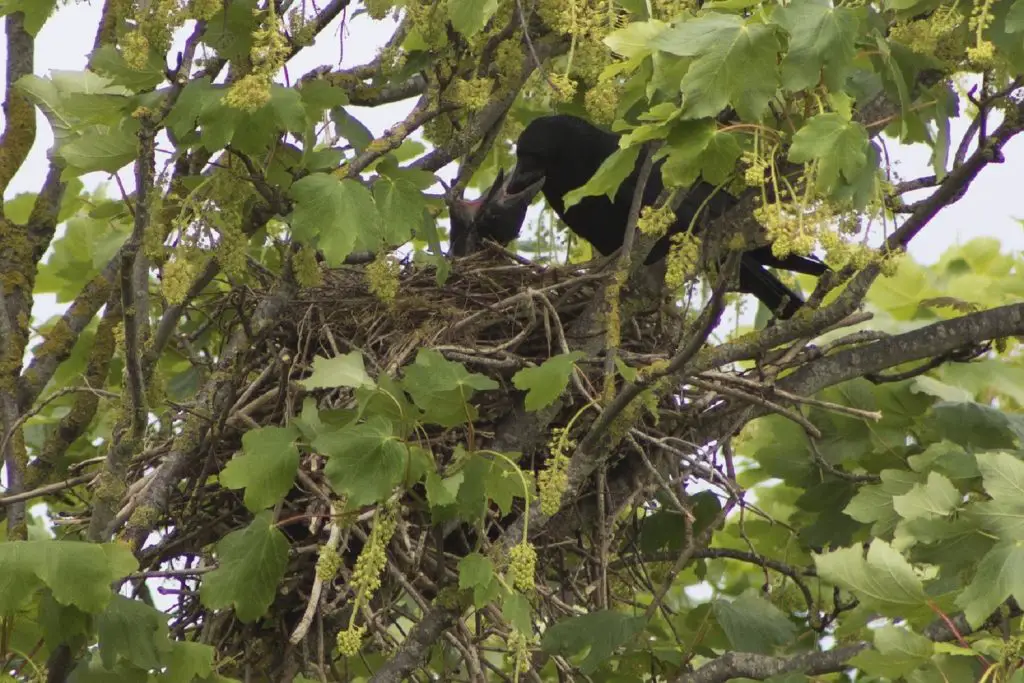
A crow’s nest is typically an extensive and bulky collection of twigs, branches, and bark lined with softer plant material, feathers, and moss. Crows prefer to build their nests as high up as possible in a tree, typically near the trunk or in a fork against the tree. In fact, their predilection for high nests is why ships call their lookout point a “crow’s nest.” Fun fact!
Crows are often like many other birds in that their nests rarely last more than one breeding season. Yes, their nests are durable, but they usually don’t survive the wind, ice, and snow expected in the winter. Interestingly, they typically build their nests in the same spot if they like it, meaning you might find crows in the same spot year after year, particularly if they have multiple babies.
Related post: How to Spot Robin Eggs and Nest
Why Do You Never See Baby Crows?
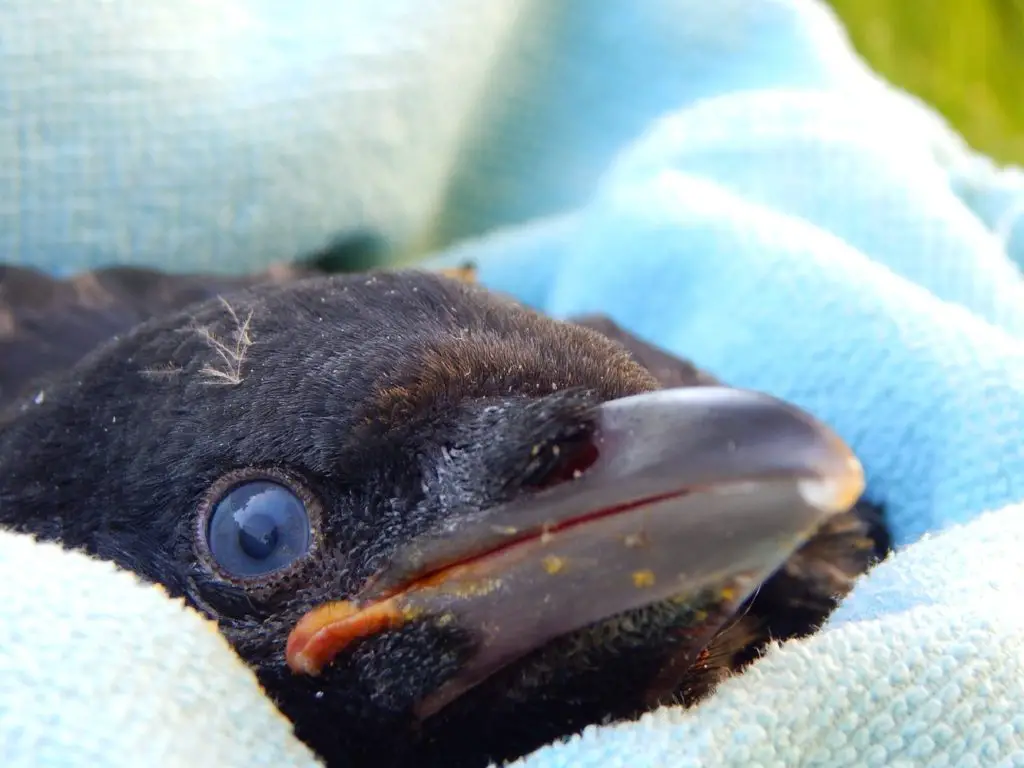
We’ve already answered this question to a degree in the last section, but we will reiterate the main point: you almost never see baby crows because their parents build their nests so high. Here’s the thing about crows: they’re smart. Wicked smart. They might have small brains, but their gray matter density (what truly dictates intelligence) is as dense as humans. They’re that smart.
As a result, they typically build their nests in odd, high places and keep a careful watch on their babies. The mother and father often split duties and are aggressive at keeping people and other animals away from their young ones. Have you ever been dived bombed by an aggressive crow in your own yard? They were probably trying to keep you from their babies.
Furthermore, there’s a good chance you’ve probably actually seen baby crows without realizing it. How? Well, baby crows are about the same size as the average adult crow once they leave the nest. As a result, you probably mistook them for an adult or another type of bird. Their feathers tend to be puffier, and their mouth pink, but those are the only significant differences.
Do Crows Mate for Life?
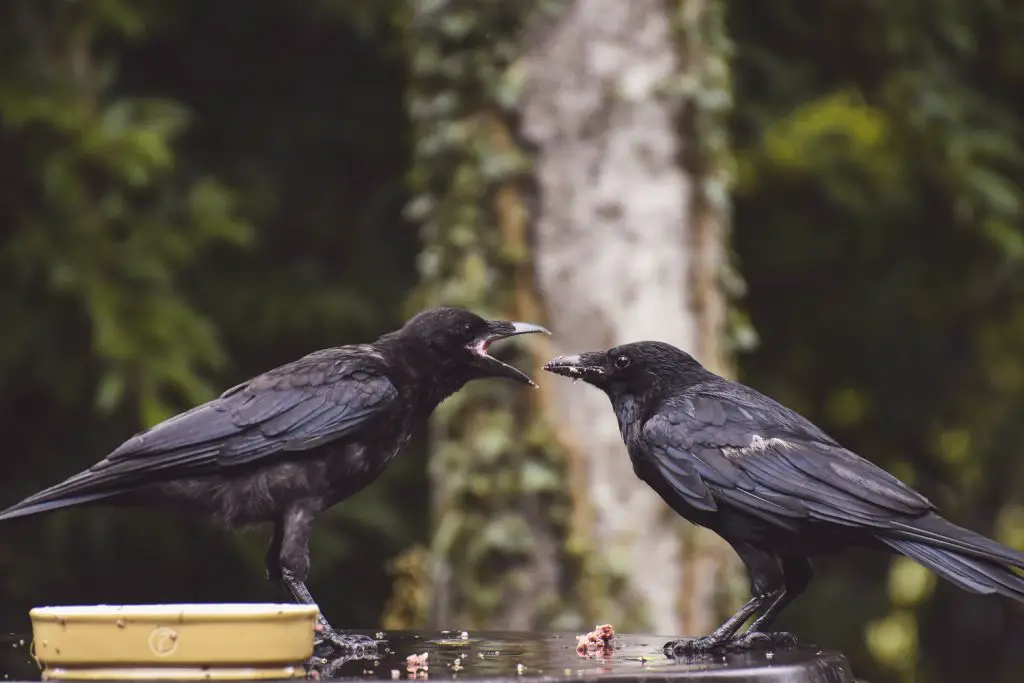
Have we mentioned yet that crows are super intelligent compared to other birds? We have? Well, have we also talked about how social they are yet? Crows not only spend lots of time with their children but even interact with their parents long after they’ve left the nest. They’ll even come to visit their elderly parents, fix their nests, groom them, and just hang out. How sweet!
In this way, crows are a lot like people: and like many of us, they mate for life. At least, most of them do. They will form strong emotional bonds with their partner and spend time with them. That said, some crows do “break up” and find other mates or have an open marriage: seriously. It’s not unusual for monogamous crows to mate with others temporarily, typically for a single season, and then return to their main partner. What beautiful, strange birds!
References:
- https://birdfact.com/articles/baby-crows
- https://www.birdzilla.com/learn/baby-crow/
- https://www.birdsadvice.com/why-do-you-never-see-baby-crows/
- https://thebirdsworld.com/baby-raven/
- https://birdfact.com/articles/do-crows-mate-for-life
- https://www.allaboutbirds.org/guide/American_Crow/id
- https://birdfact.com/articles/crow-nesting
- https://www.allaboutbirds.org/guide/Common_Raven/id
- https://www.audubon.org/news/how-tell-raven-crow